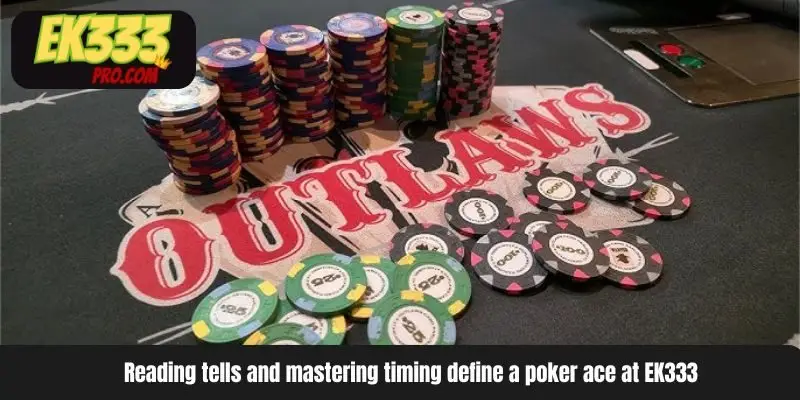Bluffing Techniques in Texas Holdem are key for players to assert their skills at the poker table. EK333 is renowned as a hub where many experts successfully apply these techniques. By knowing how to adjust timing and strategy, participants can maximize effectiveness while minimizing risks when facing opponents.
Overview of Bluffing Techniques in Texas Holdem
In the world of poker, bluffing techniques in Texas Holdem are considered a sophisticated art used to make opponents believe you hold a stronger hand than you actually do. Players employ these techniques to control the game, apply pressure, and force opponents to fold. As such, bluffing is a key element in long-term strategy, helping maintain a balance between risk and safety.
However, bluffing is not always guaranteed to succeed. Players must understand their opponents’ psychology, habits, and playing style to choose the right moment to bluff. A successful bluff can provide a significant advantage, while a failed attempt can quickly lead to losses. This is why situational awareness and careful table analysis are essential skills in poker.
Beginners often overuse bluffing, making it easy for opponents to read their strategy. Learning to balance bluffing with playing honestly is a crucial first step. In practice, bluffing techniques in Texas Holdem are not just about deception—they also reflect a player’s emotional control and finesse in decision-making.

The Importance of Bluffing Techniques in Texas Holdem
A professional player always considers bluffing as a core strategy to gain an edge, but its value goes far beyond simply trying to mislead an opponent. When used at the right moment, bluffing techniques in Texas Holdem can completely shift the momentum of a hand, forcing rivals into tough decisions and giving you greater control over the flow of the game.
Successful bluffing requires more than just courage; it’s a calculated mix of timing, psychology, and table awareness. Factors such as the size of the pot, your position, the betting history of your opponents, and even your own table image all contribute to whether a bluff succeeds or fails. Players who master these details know when to apply pressure and when to hold back, creating a balanced strategy that keeps opponents guessing.
According to statistics from the International Federation of Poker, the average success rate of bluffing is only about 30–40%. However, when applied at the right time and position, bluffing can double long-term profits compared to passive play.
The Psychology Behind Bluffing
Successful bluffing techniques in Texas Holdem rely heavily on situational awareness. Players need to observe opponents’ expressions, betting patterns, and reaction speed. Hesitation or a rapid raise can convey important signals. Understanding these behaviors allows you to identify the optimal moment to bluff.
Revealing signs of nervousness makes it easy for opponents to detect your intentions. Confidence and emotional control strengthen the impact of each bluff. Practicing the ability to hide emotions while applying pressure on opponents can force them into making mistakes, increasing the effectiveness of your strategy.
Using Math to Sharpen Your Bluffing Decisions
Bluffing in poker is never just a wild gamble—it’s a decision that requires numbers, logic, and a clear reading of the table. Bluffing techniques in Texas Holdem lose their power if they are not backed by solid probability calculations and pot odds analysis. Before even thinking about pushing chips forward, you should ask yourself: What are the chances my opponent has a strong hand, and does the size of the pot justify the risk I’m taking?
Pot odds serve as your mathematical compass. By comparing the amount you need to bet versus the total pot size, you can judge whether the reward is worth the risk. If the possible return is too small compared to your investment, bluffing in that situation becomes reckless rather than strategic. On the other hand, if the pot is large and the cost of bluffing is relatively low, the risk-to-reward ratio might make the move worthwhile.
Experienced players also use betting patterns as valuable clues. Take this scenario: your opponent checks both the flop and the turn. This often signals weakness, giving you a prime opportunity to bluff and claim the pot without needing the best cards. But if your opponent has been firing aggressive bets consistently across multiple streets, chances are they’re representing strength—or genuinely holding a solid hand. Bluffing here would be like running into a brick wall.

The right time to choose a bluff
Timing is everything when it comes to bluffing techniques. A successful bluff depends on recognizing when the situation is right, since not every hand gives you the leverage to pull it off. When your chip stack is secure and the pot is large enough, a bluff can add significant value. Conversely, with a small stack, excessive bluffing may create unnecessary pressure.
Bluffing on the river is high-risk but can yield substantial rewards if successful. Players need to understand the flow of each betting round to decide when to check, raise, or go all-in, creating the perfect bluffing scenario. A well-timed bluff not only increases the chance of winning the hand but also strengthens your table image in the eyes of opponents.
Example: You are in late position with a $200 pot. On the River, your opponent checks after strong bets on the Flop and Turn. This often indicates they may have missed their draw. If you bluff $100 (half the pot), the likelihood of success is high since the opponent will fear you have a strong hand.
Important Experience When Applying Bluffing techniques
Practical experience is the foundation for mastering Bluffing techniques in Texas Holdem. While theory can guide you, only real gameplay teaches you how to recognize the right moments to apply a bluff and when to hold back. By learning from each session, you can reduce unnecessary risks, make smarter betting decisions, and steadily increase your effectiveness.
- Always observe the table and analyze opponents’ behavior before deciding to bluff.
- Don’t overuse bluffing during the game; combine it with strong hands to maintain balance.
- Use reasonable bet sizing to increase credibility, avoiding bets that are too large or too small.
- Learn to control emotions, stay confident, and remain calm in all situations.
- Bluff only when the pot is big enough and your stack is at a safe level.
- Remember opponents’ betting history to predict their playing tendencies.
- Always have a backup plan ready in case the bluff fails.
- Learn from expert players on EK333 to further develop your skills.

Conclusion
Bluffing techniques in Texas Holdem are not just about deception but also a strategic art that requires a mix of psychology, mathematics, and experience. When applied correctly, this technique helps players create pressure, control the game, and increase winning chances. EK333 is an ideal choice to practice and refine these skills, ensuring a safe and effective experience.

 Poker Ace Strategy – Mastering Smart Play at EK333
Poker Ace Strategy – Mastering Smart Play at EK333  Poker Variants – Master the Fundamentals for EK333 Success
Poker Variants – Master the Fundamentals for EK333 Success  Self-Management and Mindset Strategies for Poker at EK333
Self-Management and Mindset Strategies for Poker at EK333  Pre-Flop Tactics In Omaha: Setting Up For The Win
Pre-Flop Tactics In Omaha: Setting Up For The Win  Texas Holdem Strategy: Skills to Dominate the Table
Texas Holdem Strategy: Skills to Dominate the Table  Omaha vs. Texas Holdem: Which Poker Style Fits You Best?
Omaha vs. Texas Holdem: Which Poker Style Fits You Best?